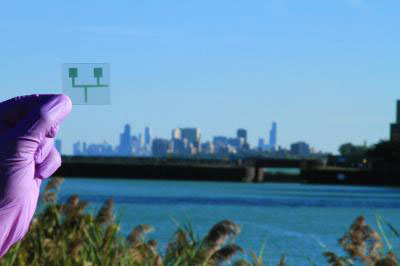| Sep 12, 2012 |
Mercury in water, fish detected with nanotechnology
|
|
(Nanowerk News) When mercury is dumped into rivers and lakes, the toxic heavy metal can end up in the fish we eat and the water we drink. To help protect consumers from the diseases and conditions associated with mercury, researchers at Northwestern University in collaboration with colleagues at Ecole Polytechnique Fédérale de Lausanne (EPFL) in Switzerland, have developed a nanoparticle system that is sensitive enough to detect even the smallest levels of heavy metals in our water and fish.
|
|
The research was published September 9 in the journal Nature Materials ("Ultrasensitive detection of toxic cations through changes in the tunnelling current across films of striped nanoparticles").
|
 |
| Commercial strip of glass covered with a film of 'hairy' nanoparticles, a kind of a 'nano-velcro,' that can be dipped into water to measure mercury levels. (Image: The Grzybowski Group, Northwestern University)
|
|
"The system currently being used to test for mercury and its very toxic derivative, methyl mercury, is a time-intensive process that costs millions of dollars and can only detect quantities at already toxic levels," said Bartosz Grzybowski, lead author of the study. "Ours can detect very small amounts, over million times smaller than the state-of-the-art current methods. This is important because if you drink polluted water with low levels of mercury every day, it could add up and possibly lead to diseases later on. With this system consumers would one day have the ability to test their home tap water for toxic metals."
|
|
Grzybowski is the Kenneth Burgess Professor of Physical Chemistry and Chemical Systems Engineering in the Weinberg College of Arts and Sciences and the McCormick School of Engineering and Applied Science.
|
|
The new system is comprised of a commercial strip of glass covered with a film of "hairy" nanoparticles, a kind of a "nano-velcro," that can be dipped into water. When a metal cation --- a positively charged entity, such as a methyl mercury --- gets in between two hairs, the hairs close up, trapping the pollutant and rendering the film electrically conductive.
|
|
A voltage-measuring device reveals the result; the more ions there are trapped in the "nano-velcro," the more electricity it will conduct. To calculate the number of trapped particles, all one needs to do is measure the voltage across the nanostructure film. By varying the length of the nano-hairs covering the individual particles in the film, the scientists can target a particular kind of pollutant that is captured selectively. With longer "hairs," the films trap methyl mercury, shorter ones are selective to cadmium. Other metals also can be selected with appropriate molecular modifications.
|
|
The nanoparticle films cost somewhere between $1 to $10 to make, and the device to measure the currents costs a few hundred dollars, Grzybowski said. The analysis can be done in the field so the results are immediately available.
|
|
Researchers were particularly interested in detecting mercury because its most common form, methyl mercury, accumulates as one goes up the food chain, reaching its highest levels in large predatory fish such as tuna and swordfish. In the United States, France and Canada, public health authorities advise pregnant women to limit fish consumption because mercury can compromise nervous system development in the fetus.
|
|
Researchers used this system to detect levels of mercury in water from Lake Michigan, near Chicago, among other samples. Despite the high level of industry in the region, the mercury levels were extremely low.
|
|
"The goal was to compare our measurements to FDA measurements done using conventional methods," said Francesco Stellacci of EPFL, co-corresponding author of the study. "Our results fell within an acceptable range."
|
|
The researchers also tested a mosquito fish from the Florida Everglades, which is not high on the food chain and thus does not accumulate high levels of mercury in its tissues. The U.S. Geological Survey reported near-identical results after analyzing the same sample.
|
|
"This technology provides an inexpensive and practical alternative to the existing cumbersome techniques that are being utilized today," said Jiwon Kim, graduate student in Grzybowski's lab in the department of chemistry at Northwestern. "I went to Lake Michigan with our sensor and a hand-held electrometer and took measurements on-site in less than a minute. This direct measurement technique is a dream come true for monitoring toxic substances."
|

